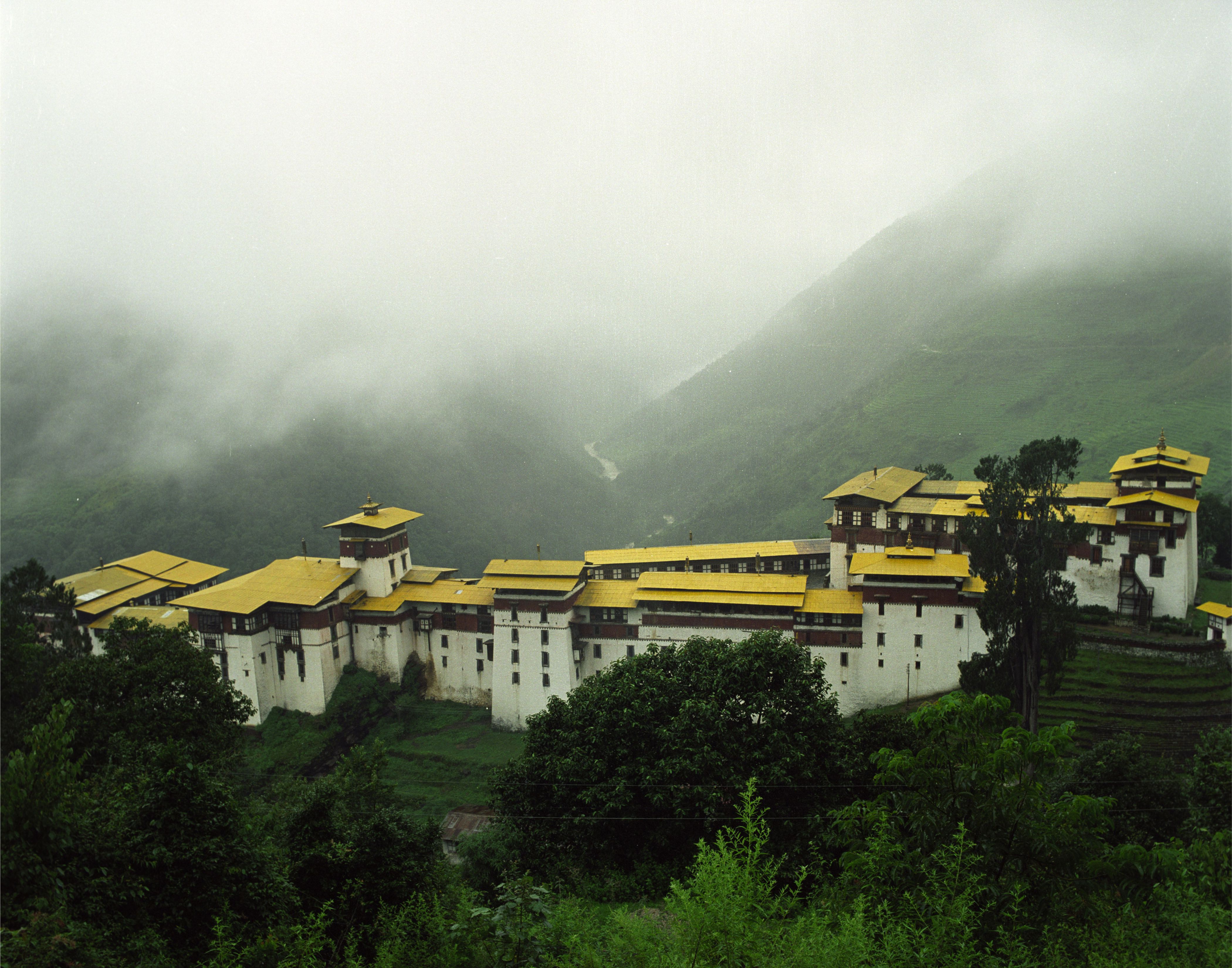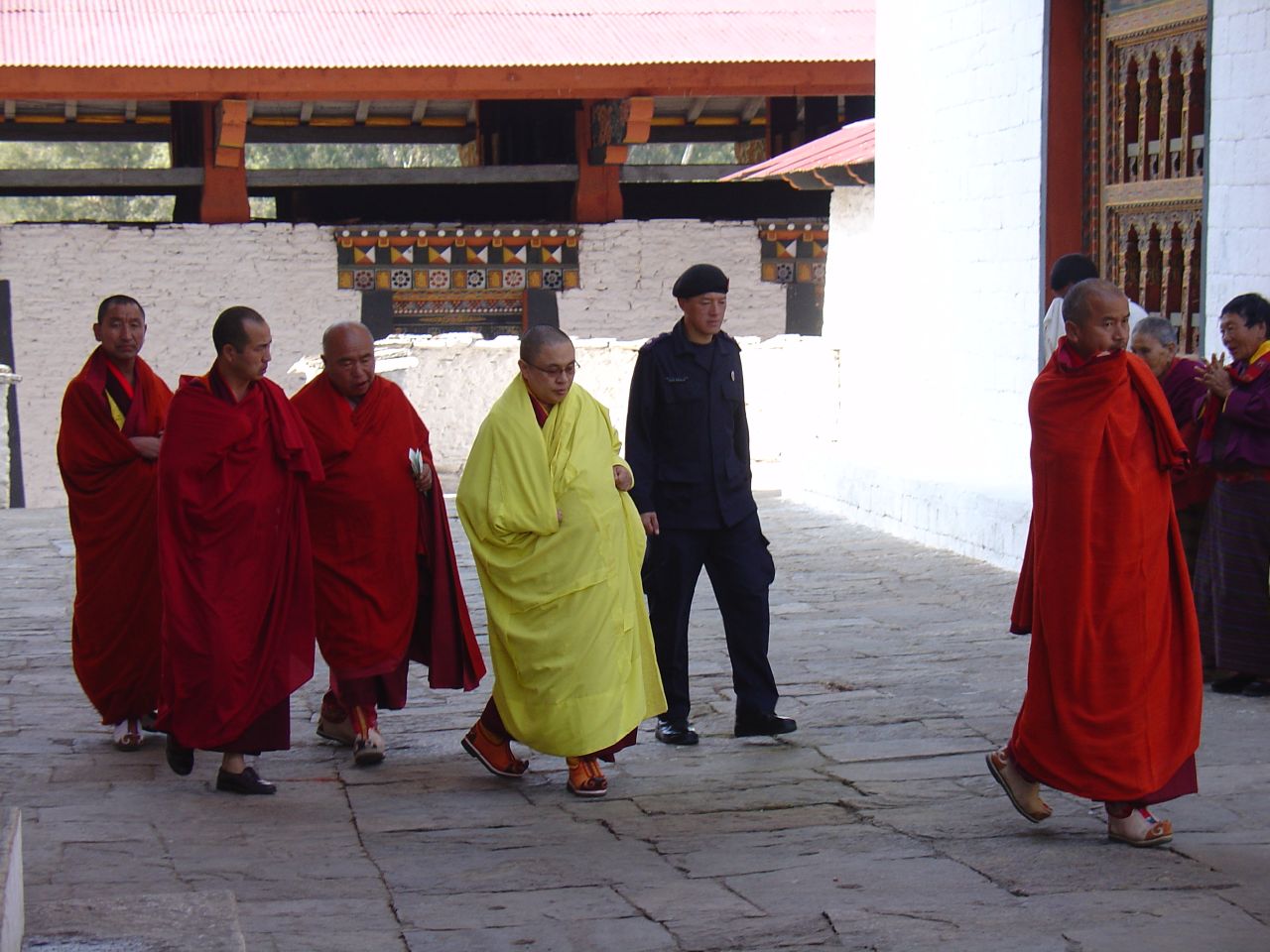|
Punakha Province
Punakha Province (Dzongkha: སྤུ་ན་ཁ་; Wylie: ''spu-na-kha'') was one of the nine historical Provinces of Bhutan. Punakha Province occupied lands in western Bhutan, corresponding roughly to modern Punakha District. It was administered from the Punakha Dzong in the town of Punakha, and the ruling governor was known as the Penlop of Punakha, or Punab. However by the 19th century, effective power over Punakha Province was held by the pro-British Penlop of Trongsa. History Under Bhutan's early theocratic dual system of government, decreasingly effective central government control resulted in the ''de facto'' disintegration of the office of Shabdrung after the death of Shabdrung Ngawang Namgyal in 1651. Under this system, the Shabdrung reigned over the temporal Druk Desi and religious Je Khenpo. Two successor Shabdrungs – the son (1651) and stepbrother (1680) of Ngawang Namgyal – were effectively controlled by the Druk Desi and Je Khenpo until power was furthe ... [...More Info...] [...Related Items...] OR: [Wikipedia] [Google] [Baidu] |
Provinces Of Bhutan
The Provinces of Bhutan were historical regions of Bhutan headed by penlops and dzongpens (both translated as "governor"). Provincial lords gained power as the increasingly dysfunctional dual system of government eventually collapsed amid civil war. The victorious Penlop of Trongsa Ugyen Wangchuck gained ''de jure'' sovereignty over the entire realm in 1907, marking the establishment of the modern Kingdom of Bhutan and the ascendancy of the House of Wangchuck. Since this time, the provinces of Bhutan have been reorganized several times into what are now the twenty Districts of Bhutan (''Dzongkhag''). Provincial titles such as Penlop of Trongsa and Penlop of Paro carry on, however, wholly subordinate to the Royal House. Traditionally, Bhutan comprised nine provinces: Trongsa, Paro, Punakha, Wangdue Phodrang, Daga (also Taka, Tarka, or Taga), Bumthang, Thimphu, Kurtoed (also Kurtoi, Kuru-tod), and Kurmaed (or Kurme, Kuru-mad). The Provinces of Kurtoed and Kurmaed were com ... [...More Info...] [...Related Items...] OR: [Wikipedia] [Google] [Baidu] |
Wangdue Phodrang
Wangdue Phodrang (, Dzongkha 'Wangdi Phodr'a) is a town and capital (dzongkhag thromde) of Wangdue Phodrang District in central Bhutan. It is located in Thedtsho Gewog. History The town shares its name with the Wangdue Phodrang Dzong built in 1638 that dominates the district. The name is said to have been given by Ngawang Namgyal, the 1st Zhabdrung Rinpoche, who was searching for the best location for a dzong to prevent incursions from the south. At the chosen spot, the Zhabdrung encountered a boy named Wangdi playing beside the river and hence named the dzong "Wangdi's Palace". Fire and reconstruction Wangdi Phodrang Dzong burnt down in the afternoon of 24 June 2012, supposedly because of a faulty electrical water cooker. However, the dzong was being renovated at the time, so most of the historical relics had already been put into storage and were saved from destruction. Shortly after the fire, more than 1000 Japanese sympathizers donated an equivalent of over US$134,500 ... [...More Info...] [...Related Items...] OR: [Wikipedia] [Google] [Baidu] |
Thimphu
Thimphu (; dz, ཐིམ་ཕུག ) is the capital and largest city of Bhutan. It is situated in the western central part of Bhutan, and the surrounding valley is one of Bhutan's ''dzongkhags'', the Thimphu District. The ancient capital city of Punakha was replaced by Thimphu as capital in 1955, and in 1961 Thimphu was declared as the capital of the Kingdom of Bhutan by the 3rd Druk Gyalpo Jigme Dorji Wangchuck. The city extends in a north–south direction on the west bank of the valley formed by the Wang Chhu, which flows out into India as the Raidāk River. Thimphu is the fifth highest capital in the world by altitude and ranges in altitude from to .Brown, p. 97Palin, p. 245 Unusually for a capital city, Thimphu does not have its own airport, instead relying on the Paro Airport (connected by road some away). Thimphu, as the political and economic center of Bhutan, has a dominant agriculture and livestock base, which contributes to 45% of the country's GNP. Tourism ... [...More Info...] [...Related Items...] OR: [Wikipedia] [Google] [Baidu] |
Paro, Bhutan
Paro ( dz, སྤ་རོ་) is a town and seat of Paro District, in the Paro Valley of Bhutan. It is a historic town with many sacred sites and historical buildings scattered throughout the area. It is also home to Paro International Airport, Bhutan's sole international airport. Paro International Airport is served by Drukair. Architecture The main street has many examples of traditionally decorated buildings. The Dungtse Lhakhang (a 15th-century temple) and the Ugyen Perli Palace are near the new bridge. Members of royal family lodge in the palace when in Paro. Nearby is the old bridge and the Rinpung Dzong. Notable hotels include the Olathang Hotel built in an ornate style. About outside Paro is the famous Paro Taktsang (Tiger's Nest) Buddhist monastery and hermitage. Some Bhutanese believe that Padmasambhava (Guru Rinpoche) flew on the back of a tigress to this location from Tibet Tibet (; ''Böd''; ) is a region in East Asia, covering much of the Tibetan ... [...More Info...] [...Related Items...] OR: [Wikipedia] [Google] [Baidu] |
Trongsa
Trongsa, previously Tongsa (, ), is a Thromde or town, and the capital of Trongsa District in central Bhutan. The name means "new village" in Dzongkha. The first temple was built in 1543 by the Drukpa lama Ngagi Wangchuck, who was the great-grandfather of Ngawang Namgyal, Zhabdrung Rinpoche, the unifier of Bhutan. Trongsa Dzong Chökhor Raptentse Dzong at Trongsa which was built in 1644, used to be the seat of power of the Wangchuck dynasty before it became rulers of Bhutan in 1907. Traditionally the King of Bhutan first becomes the Trongsa Penlop (governor) before being named Crown Prince and eventually King. Built on a mountain spur high above the gorges of the Mangde Chhu, the dzong controlled east-west trade for centuries. The only road connecting eastern and western Bhutan (the precursor to the modern Lateral Road), passed through the courtyard of the dzong. At the command of the ''penlop'' the massive doors could be shut, dividing the country in two. Higher yet on ... [...More Info...] [...Related Items...] OR: [Wikipedia] [Google] [Baidu] |
Mongol Empire
The Mongol Empire of the 13th and 14th centuries was the largest contiguous land empire in history. Originating in present-day Mongolia in East Asia, the Mongol Empire at its height stretched from the Sea of Japan to parts of Eastern Europe, extending northward into parts of the Arctic; eastward and southward into parts of the Indian subcontinent, attempted invasions of Southeast Asia and conquered the Iranian Plateau; and westward as far as the Levant and the Carpathian Mountains. The Mongol Empire emerged from the unification of several nomadic tribes in the Mongol homeland under the leadership of Temüjin, known by the more famous title of Genghis Khan (–1227), whom a council proclaimed as the ruler of all Mongols in 1206. The empire grew rapidly under his rule and that of his descendants, who sent out invading armies in every direction. The vast transcontinental empire connected the East with the West, and the Pacific to the Mediterranean, in an enforced '' Pax M ... [...More Info...] [...Related Items...] OR: [Wikipedia] [Google] [Baidu] |
Tibet
Tibet (; ''Böd''; ) is a region in East Asia, covering much of the Tibetan Plateau and spanning about . It is the traditional homeland of the Tibetan people. Also resident on the plateau are some other ethnic groups such as Monpa, Tamang, Qiang, Sherpa and Lhoba peoples and now also considerable numbers of Han Chinese and Hui settlers. Since 1951, the entire plateau has been under the administration of the People's Republic of China, a major portion in the Tibet Autonomous Region, and other portions in the Qinghai and Sichuan provinces. Tibet is the highest region on Earth, with an average elevation of . Located in the Himalayas, the highest elevation in Tibet is Mount Everest, Earth's highest mountain, rising 8,848.86 m (29,032 ft) above sea level. The Tibetan Empire emerged in the 7th century. At its height in the 9th century, the Tibetan Empire extended far beyond the Tibetan Plateau, from Central Asian's Tarim Basin and the Pamirs in the west to Yunnan ... [...More Info...] [...Related Items...] OR: [Wikipedia] [Google] [Baidu] |
Penlop
Penlop (Dzongkha: དཔོན་སློབ་; Wylie: ''dpon-slob''; also spelled Ponlop, Pönlop) is a Dzongkha term roughly translated as governor. Bhutanese penlops, prior to unification, controlled certain districts of the country, but now hold no administrative office. Rather, penlops are now entirely subservient to the House of Wangchuck. Traditionally, Bhutan comprised nine provinces: Trongsa, Paro, Punakha, Wangdue Phodrang, Daga (also Taka, Tarka, or Taga), Bumthang, Thimphu, Kurtoed (also Kurtoi, Kuru-tod), and Kurmaed (or Kurme, Kuru-mad). The Provinces of Kurtoed and Kurmaed were combined into one local administration, leaving the traditional number of governors at eight. While some lords were penlops, others held the title Dzongpen (Dzongkha: རྗོང་དཔོན་; Wylie: ''rjong-dpon''; also "Jongpen," "Dzongpön"), a title also translated as "governor." Other historical titles, such as "Governor of Haa," were also awarded. Under the dual system of ... [...More Info...] [...Related Items...] OR: [Wikipedia] [Google] [Baidu] |
Je Khenpo
The Je Khenpo (; "The Chief Abbot of the Central Monastic Body of Bhutan"), formerly called the ''Dharma Raja'' by orientalists, is the title given to the senior religious hierarch of Bhutan. His primary duty is to lead the Dratshang Lhentshog (Commission for the Monastic Affairs) of Bhutan, which oversees the Central Monastic Body, and to arbitrate on matters of doctrine, assisted by ''Five Lopen Rinpoches '' (learned masters). The Je Khenpo is also responsible for many important liturgical and religious duties across the country. The sitting Je Khenpo is also formally the leader of the southern branch of the Drukpa Kagyu sect, which is part of the Kagyu tradition of Himalayan Buddhism. Aside from the King of Bhutan, only the Je Khenpo may don a saffron kabney. History According to the dual system of government established by Ngawang Namgyal in the 17th century, the powers of the government of Bhutan were ideally split between the religious branch, headed by the Je Khenp ... [...More Info...] [...Related Items...] OR: [Wikipedia] [Google] [Baidu] |
Druk Desi
The Druk Desi (Dzongkha: འབྲུག་སྡེ་སྲིད་; Wylie:'' 'brug sde-srid''; also called " Deb Raja")The original title is Dzongkha: སྡེ་སྲིད་ཕྱག་མཛོད་; Wylie: ''sde-srid phyag-mdzod''. was the title of the secular (administrative) rulers of Bhutan under the dual system of government between the seventeenth and nineteenth centuries. Under this system, government authority was divided among secular and religious administrations, both unified under the nominal authority of the Zhabdrung Rinpoche. '' Druk'', meaning "thunder dragon", refers symbolically to Bhutan, whose most ancient name is ''Druk-yul''. ''Desi'', meaning "regent", was the chief secular office in realms under this system of government. History In Bhutan, the office of Druk Desi was established by the Zhabdrung Rinpoche, Ngawang Namgyal in the 17th century under the dual system of government. Having fled sectarian persecution in Tibet, Ngawang Namgyal estab ... [...More Info...] [...Related Items...] OR: [Wikipedia] [Google] [Baidu] |
Ngawang Namgyal
Ngawang Namgyal (later granted the honorific Zhabdrung Rinpoche, approximately "at whose feet one submits") (; alternate spellings include ''Zhabdrung Ngawang Namgyel''; 1594–1651) and known colloquially as The Bearded Lama, was a Tibetan Buddhist '' lama'' and the unifier of Bhutan as a nation-state. In addition to unifying the various warring fiefdoms for the first time in the 1630s, he also sought to create a distinct Bhutanese cultural identity separate from the Tibetan culture from which it was derived. Birth and enthronement at Ralung ''Zhabdrung'' Ngawang Namgyal was born at Ralung () Monastery, Tibet as the son of the Drukpa lineage-holder Mipham Tenpa'i Nyima (, 1567–1619), and Sönam Pelgyi Butri (), daughter of the ruler of Kyishö () in Tibet. On his father's side, Ngawang Namgyal descended from the family line of Tsangpa Gyare (1161–1211), the founder of the Drukpa Lineage. In his youth, Ngawang Namgyal was enthroned as the eighteenth Drukpa or throne-hol ... [...More Info...] [...Related Items...] OR: [Wikipedia] [Google] [Baidu] |




